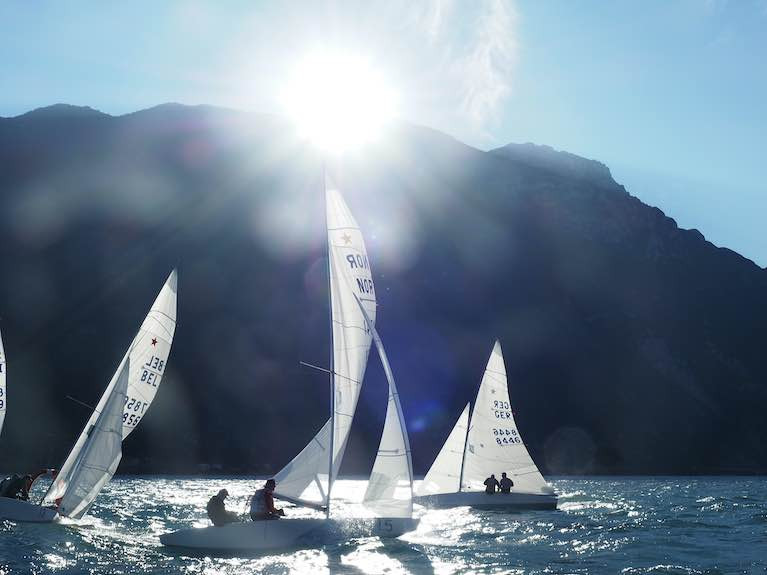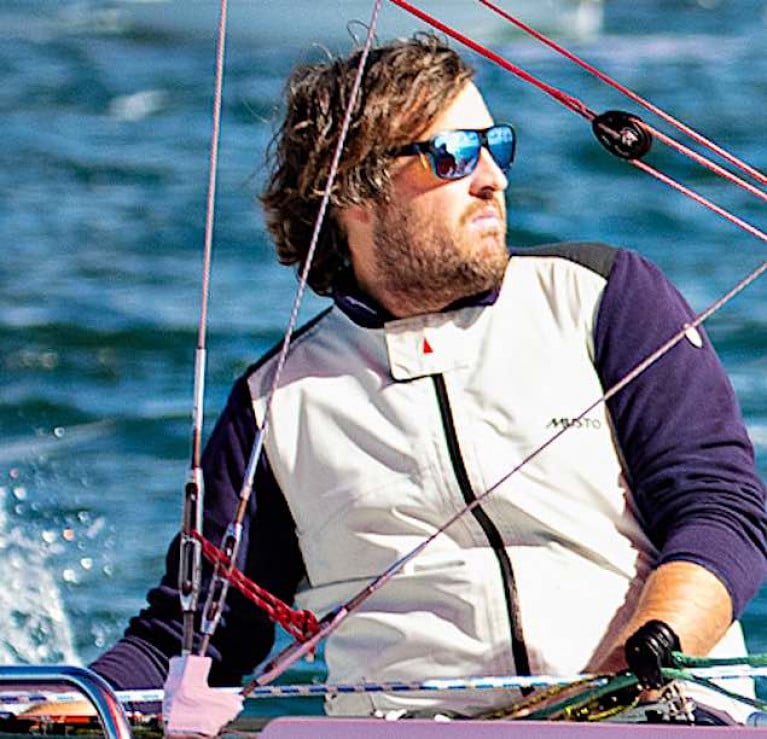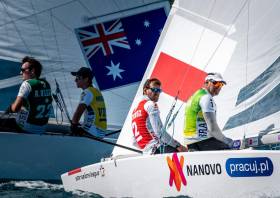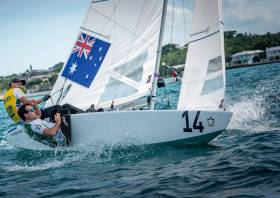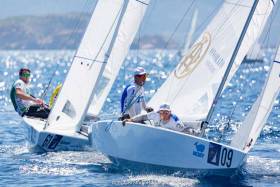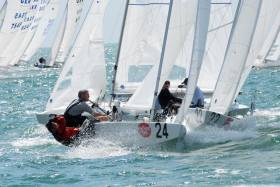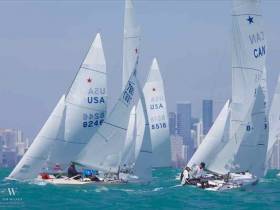Displaying items by tag: Robert O'Leary
Baltimore Sailing Club’s Star keelboat pair Peter and Robert O’Leary look to be the most likely Irish duo to fly the tricolour at the centenary Star Worlds in Marblehead, Massachusetts this September.
The 2022 Star World Championship from 8-17 September will mark 100 years of history since the first World Championship was held in 1922.
This year’s event at the Eastern Yacht Club will also celebrate one of sailing’s most popular, successful and appreciated boat and its legends.
 The world’s best Star sailors will be etched into history on the event’s coveted trophies | Credit: YCCS/Studio Borlenghi
The world’s best Star sailors will be etched into history on the event’s coveted trophies | Credit: YCCS/Studio Borlenghi
Remaining true to the heritage of the Star Class since 1922, the Worlds will be contested over six days with one long daily race, bringing together the world’s best in class alongside emerging talent in a battle of endurance, fitness, strategy and competition.
The single-race format is also reflected at the iconic Bacardi Cup, partner of the Star Class since 1927, at which the O’Leary brothers finished just shy of a podium place this past March in Miami.
Staking a place on the Star World Championship leaderboard remains as competitive as ever and the challenge for victory is as tough as the first edition back in 1922.
Baltimore Sailing Club's O'Leary Brothers Lying Second At Star Class Bacardi Cup in Miami
Irish brothers Peter and Robert O’Leary sailing their Star keelboat 'Nink Nonk' are in second overall after day one of the Bacardi Cup and happy to be out of lock-down and sailing the Star after two years.
Two-time Bacardi Cup Champions, 2020 and 2021, Mateusz Kusznierewicz (POL) and Bruno Prada (USA) controlled the opening day of racing in Biscayne Bay, Miami.
An epic line-up of fifty-eight Star Class teams kicked off racing at the 95th Bacardi Cup under a picture-perfect blue sky dotted with clouds, breeze of around 14-16 knots and choppy seas. The week ahead is looking equally stunning, with a cracking mid-teens breeze forecast through until the end of racing on Saturday, March 12.
“We have a beautiful week set up for weather and parties,” smiled Mark Pincus, Regatta Chair. “It gives us great pleasure to be able to have everybody here again and to be able to do the regatta and the week the way we normally do. We are so happy to have over 500 sailors for the week and all of our Star sailors back again that we haven’t seen in a couple of years.
“The weather is going to be phenomenal this week. There should be some great times out on the water with a great week of races and competition that we have been missing over the last couple of years. Year in year out, everyone wants to come back and sail Bacardi because they have so much fun as well as great competition.”
 Fifty-eight Star Class teams compete in race 1 at the 95th Bacardi Cup, Miami, USA
Fifty-eight Star Class teams compete in race 1 at the 95th Bacardi Cup, Miami, USA
Thrilling Opening Day
As always, the Star fleet featured plenty of World Champions, identified by the distinction of a gold mainsail logo, along with Olympians and legends of the Star Class in this high stakes battle for Bacardi Cup supremacy.
A clean start got racing underway at midday, wrapping up one hour and 45 minutes later with the win in the hands of the defending Bacardi Cup partnership of Mateusz Kusznierewicz (POL), 2-time Star Class World Champion (2019, 2008), and four-time Star World Champion (2019, 2012, 2011, 2007) Bruno Prada (BRA).
“I am honoured to be here on the 95th anniversary of the Bacardi Cup,” said Kusznierewicz. “We had a plan from the beginning to play upwind on the left side, because of the wind pattern but also the current. We knew that maybe on the beginning it would not look very good for us, but we had to be patient and then coming to the left side it will start to pay off and it did.”
 Mateusz Kusznierewicz (POL)/Bruno Prada (BRA) win race 1, 95th Bacardi Cup
Mateusz Kusznierewicz (POL)/Bruno Prada (BRA) win race 1, 95th Bacardi Cup
From 7th place at the first mark, the pair accelerated to close the gap, as Kusznierewicz joked, “We pushed a special button in our boat, we got superpowers, especially on the reaches we were performing very well and that gave us the lead.”
It didn’t start that way, as controlling the fleet for the first two legs were the California based partnership of Erik Lidecis/Greg Smith, with Lidecis saying, “We had a really nice lane and just chugged out to the left for a while, held it as long as we could, got a little leftie, tacked on it and went across the fleet, which was beautiful.”
Lidecis/Smith stayed in phase to round the windward mark first and hold their advantage to the reaching mark, before all change. The easing conditions saw the crews mostly back in the boat for the reaching legs as submarining was inevitable if too far forward, with plenty of action as crews were in and out of the boat to keep on the chine in the lulls and puffs.
“The wind was super challenging because it was a good wind, a strong wind,” reflected Bruno Prada, who is racing his sixteenth Bacardi Cup, “but especially on the downwind reaches it was a little bit less wind, so the crew movement in the boat - forward and backwards, leeward and windward – trying to balance the boat was super challenging, trying to keep the boat with a lot of power, especially releasing the back stays. There were a lot of little details that I think was our success.
“We never think about winning regattas, we think day by day, enjoying day by day and then if in the end if we do a good average, we have a good chance to win.”
 Erik Lidecis/Greg Smith (USA) led the first two legs of race 1, 95th Bacardi Cup
Erik Lidecis/Greg Smith (USA) led the first two legs of race 1, 95th Bacardi Cup
Kusznierewicz/Prada set their pole and made some gains on the first reaching leg. They had the capacity to capitalize and went low on the next leg to advance underneath the fleet, before going high in the closing metres to the gybe mark, boosting their boat speed to exploit an opening and get around everybody to take the lead into the second upwind.
As the breeze dropped to around 12-13 knots, the Race Committee changed the second lap to a downwind course format. Behind the leaders, the fleet consolidated on the next downwind and played the right side of the course more on the third and final upwind.
Whilst Kusznierewicz /Prada oozed class to extend and take the race win, thrilling tacking duels unfolded for 2nd between Peter O'Leary/Robert O'Leary and Eric Doyle/Payson Infelise, with Diego Negri/Sergio Lambertenghi and John MacCausland/Rodrigo Meireles battling for 4th and 5th place.
 Tonci Stipanovic/Tudor Bilic (CRO) compete at their first Bacardi Cup
Tonci Stipanovic/Tudor Bilic (CRO) compete at their first Bacardi Cup
Two-time Star Class Olympian (2008 and 2012) Peter O’Leary, who is racing with his brother Robert, was stoked to come out on top of their duel and claim second. Last time racing at the Bacardi Cup in 2020, the pair finished 6th overall.
“I guess if you didn’t like today, you are never going to like Star sailing!” laughed Peter. “It was good to be back in the boat after two years. We ended up reaching on the first lap and that’s a fun thing to do in the Star.”
Robert chipped in, saying, “We’ve done a good bit of training reaching, but I’ve never actually raced a reaching course, so it was a bit of a shock to the system trying to decide whether jib on pole or not. We did it for the first leg and it definitely paid, and then the second leg we were just trying to defend, keep our lane, keep the air clear going down. We got inside three boats at the gybe mark.”
An impressive passage of play from Paul Cayard/Fritjof Kleen whose broken outhaul a couple of minutes before the start left them slumped mid-fleet at the first mark, before getting back on pace to finish in 10th.
 Paul Cayard (USA)/Frithjof Kleen (GER) finish 10th in race 1, 95th Bacardi Cup
Paul Cayard (USA)/Frithjof Kleen (GER) finish 10th in race 1, 95th Bacardi Cup
Post-race, Bacardi hosted Star sailors and the Race Committee at the Bacardi Building, Coral Gables, in a celebration of the partnership and legacy between the Bacardi Cup and the Star Class.
Race 2 is scheduled to start at 1200 hours on Tuesday, March 8.
Provisional Top 10 Results – after Race 1
1. Mateusz Kusznierewicz / Bruno Prada (POL 8548) - 1 pts
2. Peter O'Leary / Robert O'Leary (IRL 8465) - 2 pts
3. Eric Doyle / Payson Infelise (USA 8423) - 3 pts
4. Diego Negri / Sergio Lambertenghi (ITA 8567) - 4 pts
5. John MacCausland / Rodrigo Meireles (USA 8448) - 5 pts
6. Eivind Melleby / Joshua Revkin (NOR 8543) - 6 pts
7. Erik Lidecis / Greg Smith (USA 8459) - 7 pts
8. Peter Vessella / Phil Trinter (USA 8573) - 8 pts
9. Tonci Stipanovic / Tudor Bilic (CRO 8540) - 9 pts
10. Paul Cayard / Frithjof Kleen (USA 1988) - 10 pts
The perpetual Bacardi Cup Trophy will be awarded to the first placed skipper and the Tito Bacardi Cup to the first placed crew, with prizes also presented to winners in the Master’s (skippers aged 50 through 59), Grand Masters (skippers aged 60 and above), Exalted Grand Masters (skippers aged 70 and above) and the Tammy Rubin-Rice Trophy will be presented to the highest placed team not otherwise receiving a prize.
Small Star Fleet Compete for European Honours on Lake Garda, Italy
With lots of Europe countries in COVID lockdown, it is no surprise this year's Star European Championships at Lake Garda in Italy has drawn only 18 competitors.
As regular Afloat readers will know, Ireland's Peter O'Leary and Robert O'Leary from Baltimore Sailing Club and Royal Cork Yacht Club are regular International attendees but the sole Irish Star duo are not competing this year.
The O'Leary brothers finished 14th overall in a fleet of 90 at the 2019 European Championship in Italy.
While this year's entry is low, the strength of the class is shown in the wide spread of ten European countries competing at Lake Garda.
Yesterday, two more extraordinary races sailed today in Riva del Garda, Italy, on the third day of racing. A strong wind from the North allowed the fleet to keep the schedule and close today Race Five and Six in the morning, granting the teams to throw out their worst score.
European Champion Diego Negri with crew Sergio Lambertenghi (ITA) were on fire yesterday, after a very slow start of the championship, winning both races with a huge margin over the rest of the fleet, and by discarding a 10th they jump up to fourth place, two points away from the podium. In third place, Croatian duo Tonci Stipanovic and Tudor Bilic, in second the Austrian team comprised of Hans Spitzauer and Christian Nehammer and on top, after four days leading, Piet Eckert (SUI) and Frederico Melo (POR) who discarded today their worst score so far, a seventh.
One more day today, and only one more race allowed to reach the maximum of seven races scheduled by the Notice of Race. If Negri/Lambertenghi can still aim for podium, the mission looks almost impossible for the team in the provisional rankings, 2017 Star World Champion Eivind Melleby with Martin Hejlsberg (NOR), eight points away from third. Nonetheless, we might still see some changes among the top teams, and the fight for the title of 2020 European Champion will be fierce tomorrow on the water.
Full results here
Rob O'Leary is September's "Sailor of the Month" (Inshore)
The O'Leary family of Crosshaven and Baltimore have a fine reputation for top-level competitive sailing allied with ready enthusiasm for volunteering in services to our sport, and Rob, the youngest O'Leary brother is following this tradition. Having served successfully as Captain of his university sailing club, he is now a newbie on the Committee of Baltimore Sailing Club in West Cork as the Honorary Sailing Secretary in this most demanding of years, when flexibility in planning and nimbleness in organisation has been the essential approach in keeping sailing alive yet compliant.
And he is equally a pace-setter afloat, having helmed the winning 1720 in the Baltimore Cup, the Southerns, and most recently the Munsters in Cork Harbour, racing in one of the most competitive fleets in the country.
Royal Cork Star sailing brothers Peter and Robert O’Leary scored their second bullet of the Bacardi Invitational Regatta in Miami, Florida and are now in striking distance of the podium, placed in third overall as they enter the last race today.
After a very stormy morning, with gusts of wind weaving through from all directions and a short postponement ashore for some classes, 542 sailors headed out to the water for the penultimate day of racing at the .
The wind eventually settled on all racecourses and the race committees made final course adjustments in response to the shifty breeze, which increased from around 6-7 knots to 10-12 knots. The building breeze backed up the forecast of a strong northerly front for Saturday’s final race day.
On the Star course magic happened and this year’s heroes were born as the 2020 Bacardi Cup Trophy was claimed. The leaders of the series, Polish Finn Olympic Champion Mateusz Kusznierewicz (POL) and Brazilian five-time Star World Champion Bruno Prada (BRA) rounded the first windward mark in the unusual position of 10th, a place they had not found themselves in all week. Tack after tack they worked their way through the tough opposition to put in another powerful performance and cross the finish line in second, securing the 2020 crown of one of the oldest trophies in the sailing arena with a race to spare.
“I’ve attended the Bacardi Cup for so many years in my Olympic career but have never managed to win it,” said an enthusiastic Kusznierewicz, who is also the reigning Star Class World Champion. “It is an unbelievable feeling to finally win this after finishing runner-up last year. Bruno and I had an amazing week, three bullets and two seconds, I can’t remember having had a regatta so perfect in my life. I think I am ready for the Tokyo Olympics,” he laughingly concluded.
With the iconic Bacardi Cup trophy securely in the hands of the Polish-Brazilian partnership, attention now turns to the fiery battle for second and third on the podium. The Irish brothers, Peter and Robert O’Leary scored their second bullet of the series and are now in striking distance of the podium, placed in third overall. They engaged in an intense fight with the USA’s Eric Doyle/Payson Infelise, who opened their day with some boat damage and just made it ashore and back out in time for the start of race 5. Doyle/Infelise had to settle for a 3rd place score to place seventh on the leaderboard. Despite scoring their worst result of the series, a 9th place, Eivind Melleby (NOR)/Joshua Revkin (USA) sit firm in second place. Tomorrow’s last race will be a gruelling battle to complete the 93rd Bacardi Cup leaderboard, with the top seven teams separated by just 12 points and all in reach of a podium finish.
“Sailing with Bruno Prada is fantastic, I enjoy it so much,” continued Kusznierewicz. “We had an amazing year together, we won the Star Worlds last June, then the qualification round for the SSL Finals and now this epic race. Of course, it’s easier to enjoy it when you are winning, but I loved this event so much, and I love sailing, I don’t ever want to stop!”
Three races were sailed in the J70, Melges 24, Viper and VXOne classes, four in the Open Windfoil, but no racing for the AV8 kite boards.
In the J70 fleet, holding firm as leaders are the team on Eat Sleep J Repeat (Paul Ward/Ruairidh Scott/Ben Saxton/Mario Trindade), who despite an unusually up and down scorecard remain the most consistent in the fleet. Second and third respectively are the teams on Surge (Ryan McKillen/John Wallace/Sam Loughborough/Mark Mendelblatt) and NINE (Oivind Lorentzen/David Shreiner/Lucas Calabrese/Ian Coleman), who each claimed a race win and showed great form around the track. The opening race win of the day went to the corinthian team on Dime (Mallory Loe/Andrew Loe/Cardwell Potts/Brian Shores) who are 15th overall and second in their division.
The door is still very much open in the J70 fleet for any number of teams to step up to the podium, making tomorrow’s final day a challenge for control of the fleet. Ending their day just two points off the podium is the team on Midlife Crisis, with Bruce Golison on the helm.
“Today was a very tricky day on the racecourse,” said Golison. “The wind was coming from all over the place with lots of gains and losses for everyone. We had an ok day, not too good and not too bad. We are looking forward to the big breeze tomorrow, it should be a lot of fun and a great way to end the Bacardi Invitational Regatta”.
In the Melges 24 fleet, overnight leaders USA 820 (Bora Gulari/Kyle Navin/Norman Berg/Ian Liberty/Taylor Canfield) had to surrender the track performance of the day to Raza Mixta (Peter Duncan/Victor Diaz de Leon/Mattero Ramian/Carlos Robles/Willem Van Waay), who claimed two firsts and a second, but USA820 holds onto first overall on tiebreak advantage. Realistically, unless there is a major change in form, the fight for first and second will be between these two teams. On an 11 point deficit to the leaders and in third overall going into the final day is Shaka (KC Shannon/Jackson Benvenutti/Ben Lynchi/Tom Sawchuk/Elizabeth Whitener). Claiming the third race win of the day was Team Sebaajo (Jan Frederik Dyvi/Jan Boro/Herman Horn-Johannessen/Malin Rorvik-Sundelin/Stian Ness Rorvik), who elevate themselves to be first corinthian team and 11th overall.
Tight margins in the Viper 640 fleet, with just 3 points separating the top three teams, led by USA 293 (Will Graves/Ryan Cox/Greg Dair) on 14 points, second to Evil Hiss (Geoff Ewenson/Mary Ewenson/Tyler Bjorn) on 15 points and in third is Ness (Mark Zagol/Tim Desmond/Arielle Darrow) on 17 points, who won the day’s opening race. Bullets also went to Gnixe (Bill Vickers/Chip Steiner/V Vickers) and Antix (Anthony O’Leary/Ben Field/Nicholas O'Leary).
Robert O’Leary Falls Short Of Last Rounds In Star Sailors League Finals
Ireland’s Robert O’Leary crewing with Australian Torvar Mirsky appeared to have lost their stride yesterday (Friday 6 December) and were the only team to drop out of the top 10 in the Star Sailors League Finals in the Bahamas.
This came after after an outstanding day three on Nassau’s Montagu Bay, when they were first to the windward mark in all three races, putting them in ninth to start the last day of qualifiers.
Highlights of day four can be watched below:
Robert O’Leary Makes Top Ten On Third Day Of Star Sailors League
Star of day three in the Star Sailors League was Australian Torvar Mirsky sailing with Ireland’s Robert O’Leary, as the pair cruised into the top 10 on a day where young talent shone through amid lighter 6-12 knot conditions on Nassau’s Montagu Bay.
With the wind due north, 2017 Match Racing World Champion Mirsky was unbeatable upwind, leading at the top mark in all three of today’s races.
However, it was only in the second when he and O’Leary converted this to their first bullet, which helped lift them up to ninth overall.
“It was a splendid day – I’m really stoked,” said Mirsky once ashore at Nassau Yacht Club. “We were struggling a little downwind, but we were at the front of the fleet, which was really cool.
“In the lighter conditions we could look around a bit so we were able to tack, play the fleet and the shifts a little bit. We held on to most of it.”
Generally the lighter conditions favoured the youngsters in the 23-team fleet.
While Mirsky and O’Leary were the class act, scoring just one point more today were Scottish Laser European Champion Lorenzo Chiavarini and his German crew Kilian Weise, whose 3-3-6 left them in seventh (following yesterday’s two DNFs). Also going well today were Brazilians Henrique Haddad and Henry Boening who posted a 2-7-7, leaving them 10th.
Another three races are scheduled for today (Friday 6 December) starting at 11am local time to complete the qualification round. After this the top 10 alone will be heading on to the finals round tomorrow.
Australian Torvar Mirsky and Cork Harbour's Robert O'Leary are up to sixth overall at this week's Italian-based Star World Championships after three races sailed in Porto Cervo. The pair sailing the Irish Star Dafne now count a 16, 8, and 10 and are two points off fourth overall. Results are downloadable below.
Yesterday was the third day of racing at the Championship organized by the YCCS in collaboration with the International Star Class Yacht Racing Association (ISCYRA) and the support of Main Partner Audi and Technical Partners Quantum Sails and Garmin Marine. The games are still open with the world class sailor Augie Diaz now in the lead followed by Eivind Melleby and Mateusz Kusznierewicz.
Again the breeze took its time to kick in and the Race Committee kept the AP flag hoisted until 1 PM. An hour later, after a general recall, the Star sailors got the event's third race underway. Breeze from the southeast was at 6 to 7 knots at first and in the end built gradually to 10 knots.
Skipper Eivind Melleby, winner of the 2017 Star Class World Championship, and his crew Joshua Revkin worked their way up through the fleet and finished in first place. This win brings them from fifth place in the provisional overall results to second. Second place today was won by Christian Paucksch with Melanie Bentele - one of just two women racing in the Championship- who have been a team to watch all through the event. The Italian Roberto Benamati, Star Class World Champion in 1991, who is sailing with Alberto Ambrosini, placed third today.
Augie Diaz and Henry Boening staged an excellent recovery and finished fourth today and thanks to this result they are currently in the lead overall, trailed by the Norwegian Eivind Melleby. Mateusz Kusznierewicz and Bruno Prada are currently in third place overall after placing eleventh today. Paul Cayard is inching up on the podium: after having finished the day in ninth place overall yesterday, he's in fourth place overall today. So the games are still open with three races left on the calendar.
The Norwegian Eivind Melleby had these words: "It was a good race with pretty stable breeze and small shifts that were hard to play but it was for everyone. Downwind we had really good speed and I think that's how we won the race. We expect to have pretty much the same conditions in the next couple of days then a bit windier on Saturday, so we're half way through the Championship and we will give it our all."
The German Christian Paucksch commented on his performance: "We had a good start on the far left near the pin and then we got every shift right up until the mark. We also had a good tactic for the first downwind run. We tried to control the fleet on the second beat and we managed to do it quite well, then on the last run the fleet split a little and we stayed with the ones going towards the shore. Eivind Melleby passed us just at the end which is too bad, but if I think that when my girlfriend and I started sailing the Star Championship together we said that we should always try to leave a boat behind. We should be very proud of ourselves today as we left quite a few behind."
Today, June 20th, the forecast calls for light and shifty breeze. The first Warning Signal is scheduled for 12 noon.
Maurice ‘Prof’ O’Connell joins the media team for next week’s Star Europeans and Star Sailors League on Lake Garda.
The professional sailor and coach, and one-design expert with North Sails Ireland, will be providing the in-studio commentary and analysis with Digby Fox for live action on StarSailors.com along with Shirley Robertson who will be out on the water.
Prof is no stranger to broadcast sailing coverage, having been in the RTÉ studios for the last three Olympic Games — and he’s certainly no stranger to the Star class, with his final race at the Star Worlds in Miami only 11 years ago.
This year Ireland’s focus will be on the O’Leary brothers Peter and Robert, set to compete against a who’s-who of the racing world from this Wednesday 15 May.
Two separate O'Leary teams both sailing under the burgee of Baltimore Sailing Club in West Cork are in action in Florida next week at the Bacardi Cup in Miami.
Former Irish Sailor of the Year Anthony O'Leary sailing with David Hassett, Niall Rafferty and Tom Durcan will sail in the Viper class while O'Leary's sons Robert and Nicholas, (Robert was a recent bronze medalist in the Star Junior Championships) will compete in the Star Class. The brothers' boat, the aptly named Star 'Brotherly Love' has been based in Miami for a string of regattas this winter.
Ninety-two years of history is a record that not many sports competitions can match. With the number of teams and the unparalleled talent on the water increasing each year, the Bacardi Cup Regatta is among the world’s most iconic sporting events. For 56 years, this event has had the pleasure of calling the beautiful warm waters of Biscayne Bay its home.
This year, the Organising Committee decided to extend an invitation not only to the Star Class, but also to other one-design fleets, making the 2019 Bacardi Cup Invitational Regatta the most attended spring sailing event. The J/70 class, the fastest-growing one-design fleet in the world, has been invited for the second year in a row, while the successful long-lived Melges 24 class will make its return to Biscayne Bay along with the high-performance classes represented by the Viper 640 and Flying Tiger 7.5!
Racing gets underway in Biscayne Bay on Monday, March 4 for the Star Class. Racing for the J/70, Melges 24, Viper 640 and Flying Tiger 7.5 classes starts Thursday, March 7. The Star fleet will compete in a single daily race of proper endurance racing, which is the traditional format that the more than 100-year-old class dictates and exactly what the sailors relish. The other four fleets will sail 8 races scheduled across three days.
Teams from across the U.S. will be joined in every class by an international line-up of 23 different countries, including Argentina, Australia, Brazil, Canada, Cayman Islands, Chile, Croatia, Denmark, France, Germany, Great Britain, Ireland, Italy, Mexico, Monaco, Netherlands, Norway, Poland, Portugal, Spain, Sweden, Switzerland and the Ukraine.
The 2019 Bacardi Cup Invitational Regatta has a recording-breaking 166 entries, with more than 500 sailors attending. World champions, Olympians and America’s Cup legends will be on the starting line. The most shining one will traditionally be the Star Class, with the many heroes that still competitively race in it and sport the Gold star on their main sail for winning at least one Star World Championship. We are excited to have competitors include the very eclectic Paul Cayard (USA), who has been sailing Stars for 40 years alongside his successful career in the America’s Cup and big yacht racing; Xavier Rohart (FRA), the Bronze Olympic medalist in the class in Athens; Lars Grael (BRA), a two times Bronze Olympic medalist in the Tornado class; and Mateusz Kusznierewicz (POL), the Gold and Bronze winner at the Olympics in Atlanta and Athens in the Finn class.
Amongst those targeting victory in the J70 fleet is Brian Keane (USA), who has raced the J/70 since the start; Vincenzo Onorato (ITA), who holds World titles in the Farr 40 and M32; Will Welles (USA) who is at the top of the leader board at just about every major J/24 regatta and Joel Ronning (USA) who finished first in the 2016 J/70 World Championships held in the San Francisco Bay.
A robust Melges 24 fleet of 26 entries are present in Miami to kick-off the U.S. class’ 2019 National Ranking Series, an eight-part regatta circuit that spans the North American continent. Returning to the impeccable Biscayne Bay racing stage is current Winter Series overall ranking leader Bruce Ayres (USA), and Megan Ratliff (USA) who is in charge of the Corinthian division. Other major players include 2013 World Champion and Rolex Yachtsman of the Year Brian Porter (USA), Travis Weisleder (USA) and KC Shannon’s (USA).
In the Viper 640 Fleet, we are welcoming back Steve Chapman (CAN) – Viper Class North American President, Geoff Fargo (USA) - West Cost Class President, Anthony O’Leary (IRL) and Mary and Jeff Eweson (USA). The Gulf Performance Sailing Foundation, a 501(c)3 from Gulfport, LA, with the purpose to promote sailing, will be sailing with all-junior crews.
The Flying Tiger Class will provide a “hassle free” regatta experience on fully rigged- and ready-to-sail boats, offering a three-day North-U Clinic where competitors can master their skills on the water.
Both Star and J/70 reigning champions will participate at the 2019 event: Diego Negri and Sergio Lambertenghi (ITA) will try to replicate their success in the huge Star fleet of almost 70 boats. Joel Ronning (USA), with his Catapult team, will try to be the fastest in the J/70 40-teams fleet.
Full results are available here


























